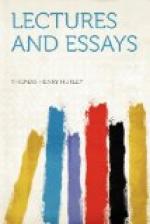In order to make the title of this discourse generally intelligible, I have translated the term “Protoplasm,” which is the scientific name of the substance of which I am about to speak, by the words “the physical basis of life.” I suppose that, to many, the idea that there is such a thing as a physical basis, or matter, of life may be novel—so widely spread is the conception of life as a something which works through matter, but is independent of it; and even those who are aware that matter and life are inseparably connected, may not be prepared for the conclusion plainly suggested by the phrase, “the physical basis or matter of life,” that there is some one kind of matter which is common to all living beings, and that their endless diversities are bound together by a physical, as well as an ideal, unity. In fact, when first apprehended, such a doctrine as this appears almost shocking to common sense.
What, truly, can seem to be more obviously different from one another, in faculty, in form, and in substance, than the various kinds of living beings? What community of faculty can there be between the brightly-coloured lichen, which so nearly resembles a mere mineral incrustation of the bare rock on which it grows, and the painter, to whom it is instinct with beauty, or the botanist, whom it feeds with knowledge?
Again, think of the microscopic fungus—a mere infinitesimal ovoid particle, which finds space and duration enough to multiply into countless millions in the body of a living fly; and then of the wealth of foliage, the luxuriance of flower and fruit, which lies between this bald sketch of a plant and the giant pine of California, towering to the dimensions of a cathedral spire, or the Indian fig, which covers acres with its profound shadow, and endures while nations and empires come and go around its vast circumference. Or, turning to the other half of the world of life, picture to yourselves the great Finner whale, hugest of beasts that live, or have lived, disporting his eighty or ninety feet of bone, muscle, and blubber, with easy roll, among waves in which the stoutest ship that ever left dockyard would flounder hopelessly; and contrast him with the invisible animalcules—mere gelatinous specks, multitudes of which could, in fact, dance upon the point of a needle with the same ease as the angels of the Schoolmen could, in imagination. With these images before your minds, you may well ask, what community of form, or structure, is there between the animalcule and the whale; or between the fungus and the fig-tree? And, a fortiori, between all four?
Finally, if we regard substance, or material composition, what hidden bond can connect the flower which a girl wears in her hair and the blood which courses through her youthful veins; or, what is there in common between the dense and resisting mass of the oak, or the strong fabric of the tortoise, and those broad disks of glassy jelly which may be seen pulsating through the waters of a calm sea, but which drain away to mere films in the hand which raises them out of their element?




